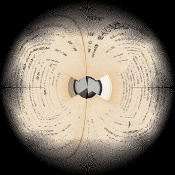中心からの距離をk-meansの要素に使えないかなと思って、作ってみた。

import sys
import cv2
import numpy as np
import math
def main():
if len(sys.argv) != 3:
print "./circle_transform.py <in_file> <out_file>"
quit()
filename = sys.argv[1]
outfile = sys.argv[2]
image = cv2.imread(filename, cv2.IMREAD_COLOR)
if image is None:
print "input file is not found"
quit()
circle = np.zeros([image.shape[0], image.shape[1], 2], dtype=np.float)
center = [image.shape[0]/2.0, image.shape[1]/2.0]
for i in range(0, image.shape[0]):
for j in range(0, image.shape[1]):
pos = [i-center[0], j-center[1]]
if pos[0] == 0: continue
circle[i,j,0] = 1.0 - max(abs(pos[0]/center[0]), abs(pos[1]/center[1]))
circle[i,j,1] = math.atan2(pos[1], pos[0])
img_out_size = max(image.shape[0], image.shape[1]) / 2.0
img_out = np.zeros([img_out_size, img_out_size, image.shape[2]], dtype=np.uint8)
out_half = [img_out.shape[0]/2.0, img_out.shape[1]/2.0]
for i in range(0, image.shape[0]):
for j in range(0, image.shape[1]):
dist = circle[i,j,0]
rad = circle[i,j,1]
idx_x = (math.cos(rad)*dist*out_half[0] + out_half[0])%img_out.shape[0]
idx_y = (math.sin(rad)*dist*out_half[1] + out_half[1])%img_out.shape[1]
img_out[idx_x, idx_y] = image[i, j]
cv2.imwrite(outfile, img_out)
main()
最適化した。



